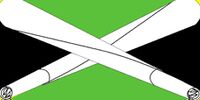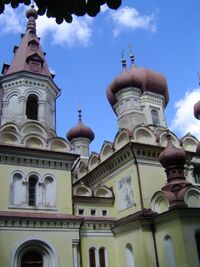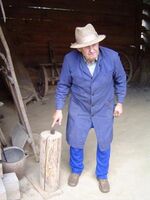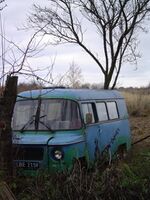Kingston

| |
| Population | Total - 75 |
Kingston is the heart of the county of Kent or Surrey, although this often overlooked cultural gem is frequently bypassed in the burning heat of devotion that takes people from the port of Dover to the City of London and beyond: to them, Kingston, land of the blessed, appears merely as a darker stain of green on a mildly distant hillside. Please note: despite any evidence to the contrary, Kingston is not the capital of Jamaica, nor does it lie by the River Thames. This was proved quite conclusively by Bob Perkins of 3 Church Lane, by the following simple observations: the lack of hot summers and the lack of a river.
Contrary to popular belief, the votes of the constituents from Kingston do not count towards the elections for the Mayor of London. The votes are burned on the border of London before they enter the city, which makes perfect sense considering Kingston is not in London.
Kingston is often referred to as 'The Penis of London' due to its distinctive shape and reputation.
History[edit]
The earliest that is known about this ancient village, for want of extensive archaeological research beyond that undertaken by Bob Perkins in the garden of 3 Church Lane during the potato harvest, is that it formed one end of the defensive line for the fair people of Kent against the foreign Romans. To quote Bob Perkins: “The latter only desired to chain the countryside with their roads of stone, to steal our apples and to laugh at our cooking.” The failure of the defence, and the resulting annexing of Britain as part of the Roman Empire, is a matter of history, although there is no evidence that the residents of Kingston had any part in contributing to this defeat.
Probably the most significant artefact ever discovered in the village is the Kingston Brooch. Currently on loan to a small museum in an even smaller riverside city north of the Watford Gap, this Anglo-Saxon example of the goldsmith’s work was discovered in a barrow on the Downs above the village. A barrow, or tumuli to give it its correct Latin name, is an earthen burial mound dating from the Saxon period, as opposed to the Perkins’ garden transporter. One Bryan Faussett, on a bright and breezy 5 August 1771, recovered the said artefact and was off on his legs (local slang: “legged it”) before Farmer Philpotte could as much as utter “Oih, ‘oo ‘r ye, diggin’ in me field?”.
The pretty 10th century church has many times been the subject of drawings, and much can be inferred from these concerning the development of the village since the times of the middle ages. The increasing number of graves in succeeding pictures well illustrate the rising death rate in a much livelier way than any parish record could, combining as it does both the quantity of the headstones with the quality of the stonemasons work. Recent photographs show fewer stones, thus both indicating the falling death rate and accounting for the rise in the village population over the past few decades. As Grandpa Perkins said: “Death might have been good enough for my grandfather, but I can’t afford to miss the next episode of Eastenders.”
The Great Fire of 1970. While not causing any damage to the village, concerning as it did the neighbouring village of Barham’s windmill, this event was visible to and enjoyed by all the residents nonetheless. The village’s own mill had been out of use for many years, and the loss of the Barham mill, ‘that Black Mill’ as it was often called, was not seen as a particular loss although some protests were made to the Barham parish council at that time indicating that, if they were going to have a disaster, could they please not make it an environmental one in future. However, in terms of interest, this event has been even more highly rated locally than the infamous case of the Perkin’s disappearing suit of 1954, 1969 and 1982.
While the founding of this ‘towne of the kinge’ is lost in pre-history, there is a story that one day a son of the village will rise up and, with a weapon mightier than the sword, bring waste to the world, and be known in all its four corners. On this day the village shop shall be reopened, the railway shall return, and the local bus shall stop four times a day in each direction and take the residents to the destinations they desire, and not charge more than two pence.
Geography[edit]
Kingston lies high on the Downs, a range of hills extending across the county of Kent to somewhere to the west that is reputedly home to the barbaric Surrey tribe, well known for their love of horse and a sacred tradition known as the ‘skulrun’. The Downs are formed from chalk, a soft and soluble calciferous rock laid down during the Cambrian period, and once much loved by teachers everywhere as the ‘bedrock of education’. Indeed, in earlier times, Kingston was once a site of pilgrimage for teachers from as far away as the next village, and they would walk up and down the Downs, crying “What’s the capitol of Washington!”
The village itself lies on the western side of the Elham Valley, which cuts through the Downs like a knife through hot cheese. Through this valley flows the Nail Bourne (‘bourne’, or ‘burn’ meaning ‘stream’ or ‘small river’). The Nail Bourne has long been a bone of contention between Kingstonians and Barhamites, the former disappointed that their stream only flows one year in seven. According to local legend, the Elham Valley was always dry until St. Augustine arrived one day and struck a stone in a field in the village of Lyminge. Water bubbled up from this stone and has flowed down the valley ever since, but, in the words of Grandpa Perkins “Those pilfering Barhamites, they stoll all the water!”
This lack of water in East Kent rivers continues to be a problem, with some plans to pipe cleaned sewage water all the way from Dover to Lyminge. On the positive side, since about 98% of all river pollution is found in the water, if one were to remove the water from a river one would reduce the pollution by a factor of 49, making the Nail Bourne one of the most ecologically clean rivers of Western Europe.
Places in the village today[edit]
Black Robin Public House. Possibly the most easily remembered building in the village, lying as it does on a difficult bend on the high road between the City of Canterbury and the villages of the Elham Valley. The name of this fine drinking establishment (‘public house’, or ‘pub’), which also offers restaurant facilities to gladden the cockles of any family’s heart, refers to a gentleman of the highway. The story is that, back in the 18th century, Black Robin was a common scoundrel who used to stop and rob mail coaches on the nearby highway. One day he was ‘caught’ and hung at Barham crossroads, hence we can discount the story completely as the Barhamites having always been jealous of anything Kingstonian. The truth is that Black Robin, Prince of Trees, was a protector of mail coaches, saving them from the depredations of the scruffy Barhamites.
The Barn. Formerly the tithe barn, which is a place once owned by the church for the purpose of taxing the locals in terms of goods to go towards the upkeep of the village church, the vicar, the vicar’s family, the bishop, the bishop’s family, the bishop’s private network of informers, the archbishop of Canterbury, and so forth. One tenth part of all one’s goods had to be given to the church each year as a ‘tithe’. Indeed, the author still recalls a three-legged dog running around the village as late as the 1960s, it having been ‘tithed’ as a puppy. These days the barn plays the role of village hall, and they say that on a quiet morning you can hear the sounds of long finished coffee mornings, jubilee parties and Sunday School lessons.
The Street. Long centuries ago, Kingstonians predicted the arrival of universal mapping engines during one particularly successful party at the Black Robin public house, and therefore decided to name their main road ‘The Street’. Now, long after the beer has been mopped up and all hangovers a distant memory, one can view the maps of Kingston on Google or Yahoo and see how they mark the main road as “The St.”
Marley Lane. Inclusion of the folks who live along this lane as part of Kingston has been questioned by some in the village as the lane is, according to some, ‘Over t’hill”. Although located at a higher altitude on the Downs than the village proper, one goes ‘down’ to visit the lane, and they come ‘up’ to the village.
The Railway. Arriving in the village in 1887 and departing again 60 years later in 1947, the villagers still want to know when they can expect the next train. The major concern is that the last train to pass through the village was heading to Barham, and it is firmly believed that the Barhamites stole it and broke it up for its scrap value. Strong evidence for this can also be found in the fact that the rails and sleepers disappeared two years later in the same direction.
The Back Field / Front Field / Top Field. Long before the invention of compasses, navigation in the village was eased by the concept of field naming. The field in front of your house was the Front Field, the one behind being the Back Field, while any field immediately higher than your house was the Top Field. Some slight criticism in the basic precepts lying behind this system, most frequently made by townies (Kingston slang for the citizens of Canterbury and Bridge), mainly revolving around the differing locations of the village houses, ignores the simple fact that when any two villagers discuss fields, each knows where the other lives: the Perkins’ Front Field might be the Philpotte’s Back Field in practice, but the Perkins and the Philpottes are fully aware of this.
The Big House. The high flint wall keeps the inmates of the Big House safely in check, as the last thing a village needs is people from the Big House ‘getting involved’, because ‘getting involved’ is Big House talk for ‘taking over’. Following long centuries where the inmates of the Big House made all the decisions in the village, or ‘care-taking until the King returns’ as they called it, the last century has seen a continuing degradation of their influence. In these more enlightened times, the wearing of smocks, the tugging of forelocks and the mindless slaughter on the battlefields of Europe has been replaced with the right to grow potatoes the way one likes, thank you very much.
Customs[edit]
Bonfire Night. On the evening of every 5th of November, the good people of the village gather at its highest point to burn wood, old chairs and other items of a combustible yet undrinkable nature, to light fireworks, to eat pickled eggs and to generally go ‘oh’ or ‘ah’ for particularly spectacular light displays. Oxygen is available for those living at the lower end of the village in case of problems breathing at these high altitudes.
The day leading up to this fiery excess is almost as enjoyable as the event itself, with children gleefully stacking old furniture, branches, Bob Perkins barrow, old toys, the Philpotte children to make the bonfire, with clothes being donated to create the ‘Fork Guy’, who is placed on top of it. The Fork Guy is thought to represent the thunder god, Thor, but there is much speculation over why the villagers should want to burn him. Whatever the history, the 1954 guy is still considered to have been the best rendition in memory, followed closely by the guys of 1969 and 1982.
The popularity of this event has proved so great that now you can find it celebrated all over England, although a scurrilous urban legend has since been circulated attributing its source to a ‘gunpowder plot’. This is obviously untrue, as the only plots in the village have been vegetable plots, and everyone knows you cannot grow gunpowder. See Bonfire night.
Naming Traditions. Village tradition extends to giving the same names to different children born in the village, such as ‘Leonard’ for an eldest child and ‘Peter’ for the youngest. This is of great convenience when visiting one’s neighbours as one does not have to go through the tedious process of memorizing of every child’s name, especially in earlier centuries when many of the same ‘sprogs’ [old kingstonian for ‘child of parents’] failed to make it to maturity.



